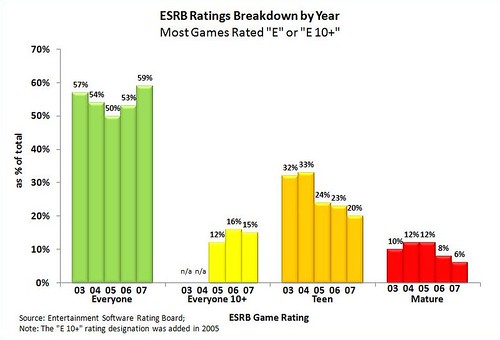If the comments of some lawmakers and video game critics were any guide, the public would be led to believe that most video games are filled with explicit violence or sexual themes. But that’s a myth. The fact is, as I pointed out in my 2006 PFF study “Fact and Fiction in the Debate Over Video Game Regulation,” the vast majority of video games are appropriate for young kids. That is, the majority of video games are rated “E” for “Everyone” or “E 10+” for “Everyone 10 and older” by the Entertainment Software Rating Board (ESRB).
I decided to put together an updated chart illustrating this fact in preparation for a keynote address I will be delivering at a Penn State University conference in early April entitled, “Playing to Win: The Business and Social Frontiers of Videogames.” Here is the breakdown of ratings by major category from 2003-2007.
This chart illustrates that well over 50% of ratings assigned by ESRB are for titles rated “E” for “Everyone,” and if you add in ones assigned the “E10+” rating, the total each year exceeds 60%, and 70% more recently. Meanwhile, the number of games rated “T” for “Teen” or “M” for “Mature” has been falling relative to the other options available.
Consequently, it would be difficult for policymakers or game critics to build the case for video game regulation on the contention that most games made today contain extreme violence or sexuality. Moreover, while it is true that games rated “T” can include some violent content, it is typically not the sort of violence that would rise to a level of serious concern for most parents. For example, lightsaber fights in “Star Wars” games or knockouts in boxing games might qualify those titles for “T” ratings, but is that really the sort of violence that concerns most parents? I know it doesn’t trouble me much. Regardless, parents get that information on the back of the game box to make their own determination for what is best for their families. Remember, the ESRB assigns not only the age-based ratings, but also a variety of “content descriptors” that make it perfectly clear what the kids will be seeing or hearing when they play certain games.
Importantly, some of the criticisms aimed at those games which do contain violence ignore the potential positive aspects of some of those games. Many news reports or congressional hearings focusing on violence in video games simply show a few looped sequences of blood or gore from a handful of titles. No other context or information is provided about the nature or content of those games.
Consider popular games such as Resident Evil, Halo, and Metal Gear Solid. It is true that these titles contain violent action, gunplay, and plenty of zombies, aliens or just plain bad guys. But it is also true that these games present the player with elaborate worlds to explore, mysteries to solve and puzzles to crack. They are enormously challenging and thought-provoking, especially when compared with much of the “passive” media content and “couch-potato fare” of the past. Many of these games even require the use of a “player guides” or “walkthrough manuals” to conquer various tasks or “levels.” Thus, there may be positive (even educational) aspects associated with these cognitively challenging games. Regardless, the simplistic criticisms and generalizations some critics make about “violent” games often seemed based on an ignorance of what those games are really all about. Indeed, one wonders if any of the critics have bothered sitting down and playing some of these games on their own or with their children. “Video games are most threatening to adults who have seen images of them but never tried to play them,” notes Gerald Jones, author of Killing Monsters: Why Children Need Fantasy, Super-Heroes, and Make-Believe Violence.
In sum: Not all games are violent, and even those that are may have many redeeming qualities. Regardless, as a parent, if you don’t want your kids playing those games, every game console has easy-to-program parental controls to set the appropriate level of gaming content you want your kids to see. Or, just exercise your “power of the purse” and just don’t buy them the game! These things aren’t free, after all.


 The Technology Liberation Front is the tech policy blog dedicated to keeping politicians' hands off the 'net and everything else related to technology.
The Technology Liberation Front is the tech policy blog dedicated to keeping politicians' hands off the 'net and everything else related to technology.